
Thank you for visiting HOJO website. If you have any enquiry, please feel free to get in touch with us at
▼ Akira Hojo
▼ Hojo Newsletter
▼ HOJO FACEBOOK





HOME > Green Tea >Kasuga Zairai Sencha
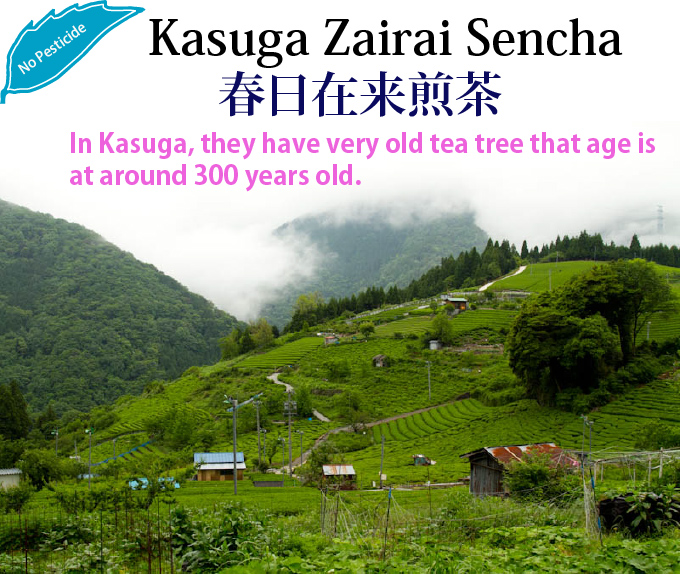
Kasuga Zairai Sencha is produced in Gifu Prefecture, at a place called Kasuga in Ibikawa-town, Ibikawa-Gun. Kasuga used to be an independent village. In 2005, Kasuga village was united with several small villages and becomes Ibikawa-town.
Non-pesticide Village
Kasuga Zairai Sencha is made without any usage of pesticide. Indeed, the entire Kasuga village is not using any pesticide; it’s very eco-friendly. In the tea garden, I noticed a lot of flying insects. Please refer to the following photo; it was taken in November 2010, when I visited Kasuga tea garden.
Kasuga tea gives an excellent after taste due to the following reasons:
The farmers in Kasuga village spent a lot of efforst to prepare the natural fertilizer for tea trees. For instance, they went deep inside the mountain to collect grasses and sometimes they gathered straws from the field. Those natural materials are very rich in minerals and thus it contributes in increasing the sweetness and after taste of tea.
Nowadays, due to the aging of society in Kasuga, the number of old tea tree is drastically reduced. Many farmers switched to young tea tree or other cultivar, like Yabukita cultivar. Yabukita cultivar has very shallow roots that spread wider under the ground, while most of Zairai cultivar has much longer roots that penetrate deeper under the ground. From this point of view, I would say that if both Yabukita and Zairai cultivar is produced under the same environment, the quality of Zairai is definitely better in terms of after taste and flavour.
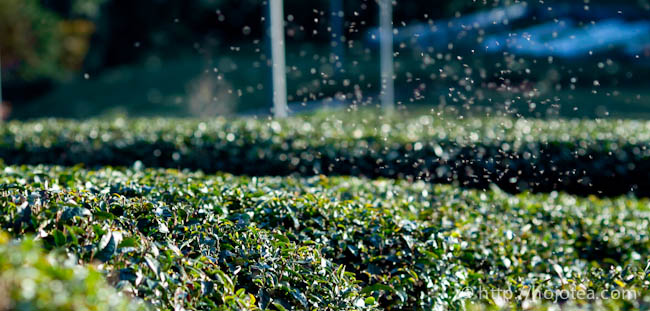
There were a number of insects flying around the tea garden of Kasuga when I visited there on November. The agricultural prctice in tea garden of Kasuga is eco-friendly.
Most of the Japanese green tea available in commercial market is produced from garden tea tree at very young age. On the contrary, Kasuga Zairai Sencha is produced from very old tea tree, aged about 200-300 years old. In general, ordinary Japanese green tea gives a very upcoming “umami” taste, while Kasuga Zairai Sencha gives a totally different drinking feeling. This tea gives a very deep after taste and long lasting sweetness. You can enjoy this tea even though you drink while pinching your nose. Its flavour stimulates the palate, and it gives a fresh floral bouquet that lasts for a long time. Furthermore, Kasuga Zairai Sencha has clarity and a fresh pure taste, and is a rare treat when of Japanese green tea. Good tea always rich in taste and complex in flavour. Even though you lost your ability to smell, you still will feel the three dimensional feeling in taste.
We sourced Kasuga Zairai Sencha specifically from the old tea tree aged about 200-300 years old. The old tree in Kasuga does not grow as tall as the ancient tea tree in Yunnan or Phoenix Mountain in China. In Kasuga, farmer manages the shape of tree and keeps it just up on the ground. The cultivar of the old tea tree is called Zairai. Zairai means "native" or "conventional" in Japanese language. It is refers to the cultivar that existed in Japan since long time ago. However the name "Zairai" is not really appropriate since tea is not a native plant of Japan. It was brought from China once upon a time. So Zairai is actually means tea that follows the original China tea bush. In fact, Zairai comprises of many traits. A few hundred years ago, tea was grown with seedling method, unlike the modern tea plant which is propagated by cutting method. If you ever visited Zairai tea garden in Kasuga, you may see that there are so many different traits of tea; the appearance of each trait varies a lot in terms of its size, shape, and colour, not to mention its flavour and quality. In a way, it is mixed cultivar that carries some genetic traits of China bush. In fact, many exclusive China teas are also produced from mixed cultivar, such as Long Jing, Junshan Yinzhen, Puerh and even Phoenix Oolong tea. Under the circumstances, there are advantages and disadvantages as follow:
In Kasuga, each tree of Zairai cultivar produces pretty high quality leaves. However, if the leaves from the different trees are mixed, sometimes the after taste is reduced and vice versa.
Considering this matter, HOJO gives emphasis to farmer to supply tea from single garden. We have an agreement to purchase the whole quantity of tea produced from single garden. Since we follow the same combination of tree, the quality is more stable.
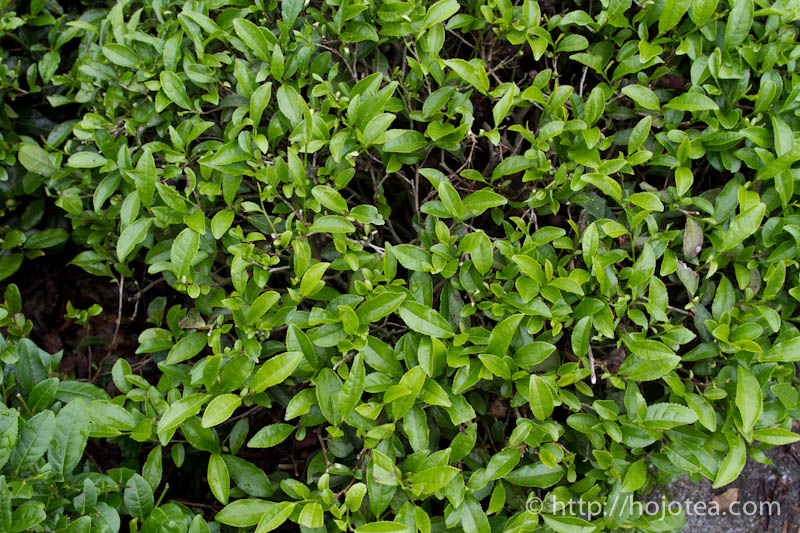 |
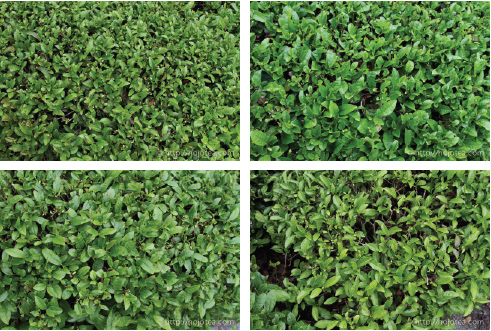 |
|
 |
 |
In Kasuga, traditionally they do not carry out the tea refining process. In Kasuga, tea is sold as "ara-cha"(荒茶), means crude tea. It has slightly higher moisture content, some stalks, and bigger leaves. If the shape and size of tea leaf is overly inconsistent, it gives noise in taste. Instead of directly pack tea with our packaging, we send the crude tea to Shizuoka for refining process. Additional sorting process is carried out to separate the stalks, big leaves and remove any foreign material such as stone, if any. After sorting, the size of tea leaf is re-adjusted, and then very moderate firing is applied to exalt its flavour. With series of cares and watchful judgement on each criterion, we managed to bring in tea with balanced character in terms of flavour and taste. As we are just buying from a single and selected tea garden, this tea is limited.
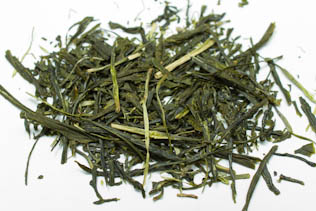 |
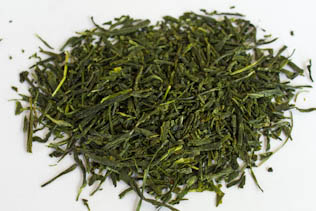 |
|
BEFOREThis is the crude Kasuga green tea which is commonly available in Kasuga for sale. Tea contains a lot of stalks and appreance is not consistent. |
AFTERWith our own spec, tea was sorted, cut and lightly fired. The leaf shape and color is consistent. |
In Japan, the quality criteria of tea are set by Shizuoka tea market and it was greatly influenced by the Japanese agricultural association. The agricultural association wishes to supply more nitrogen based fertilizer. They emphasize on "umami", and this comes from "thiamin", the typical substance produced when nitrogen based fertilizer is applied before harvesting. "Umami" is known to be the most important quality index of Japanese green tea; nevertheless, tea with very thick umami taste gives very flat and shallow after taste. Based on my experience, fruit or vegetable will not produce a good outcome if nitrogen based fertilizer is applied before harvesting. For example, if nitrogen based fertilizer is applied to vegetable, it taste becomes flat and flavour becomes very thin. If it is applied to apple or grapes, the tree grows very fast due to the nitrogen intake. As a result, fruit becomes very small and the taste is not enjoyable after all. The nitrogen based fertilizer does the same job with tea. It makes tea grow faster and increase the output. Certainly, farmers are happy since they have more volume of tea to sell. Agricultural association also feels happy because they can sell more fertilizer. Due to this close relationship among farmers and agricultural association, until now "umami" remains as the key quality index; even the professor in university is supporting this idea. If one has ever studied the very exclusive tea produced in China or Taiwan, none of the quality tea is produced with nitrogen based fertilizer. The higher the quality, the slower the tea grows. As less number of tea leaf dominate the limited minerals supplied from the root, we enjoy the thickness of the taste. Kasuga tea gives taste just like very high-end Chinese green tea or raw Puerh tea. If we ever taste this kind of Japanese green tea, it is hard to get back to the ordinary tea that just simply gives strong umami.
Pease click each photo to enlarge.
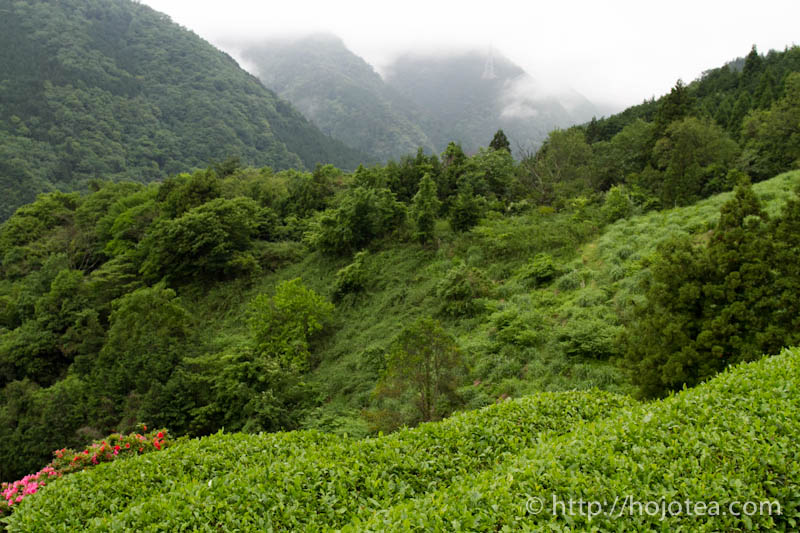 |
 |
 |
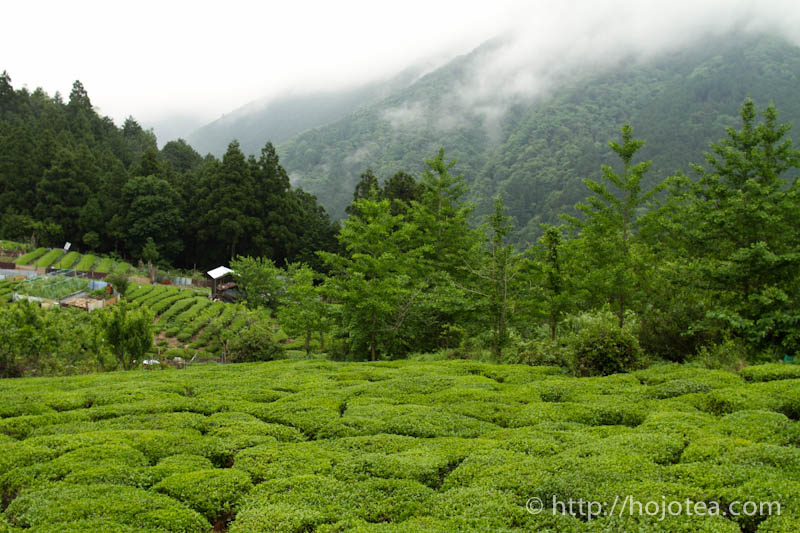 |
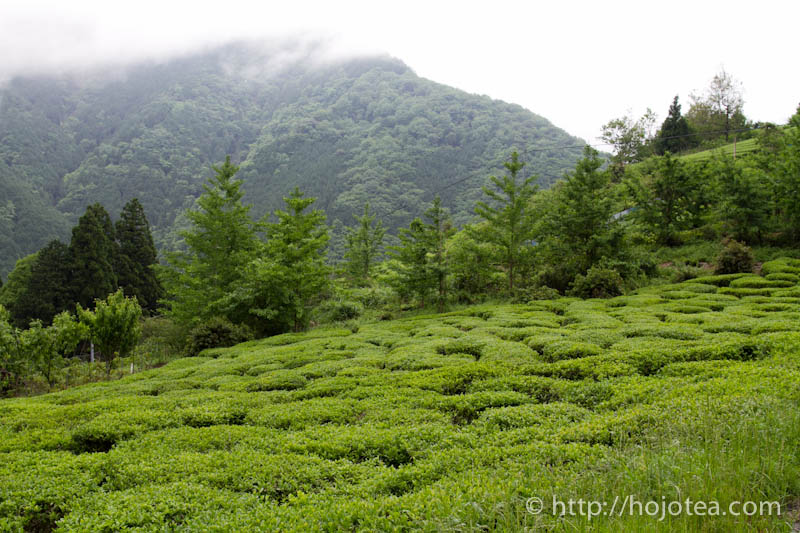 |
 |
 |
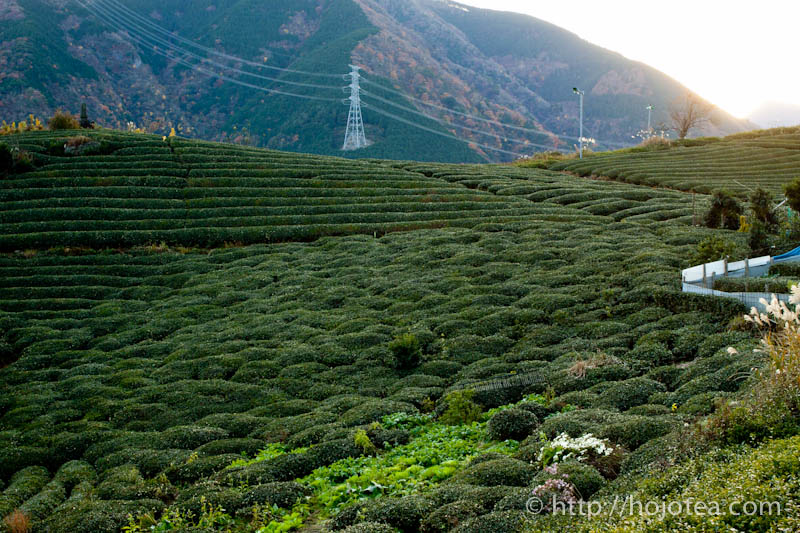 |
In you are using tap water, it is necessary to filter the water using an activated carbon filter. If not, you wouldn’t be able to enjoy the authentic taste of tea. Chlorine is added to tap water in order to sanitize bacteria. This chlorinated water will also harm our body cells. Concerning about our health condition, it is very important to remove chlorine from drinking water. The most effective method in removing chlorine is to install an activated carbon filter. This type of filter is designed for removing organic substance. It will remove not only chlorine, but also other harmful substance such as contaminated pesticide. The activated carbon filter can be easily obtained from the common hardware shop in most countries. If activated carbon filter is not available, please place a charcoal inside the water and leave it for over night. The material composed of activated carbon filter is made of ground charcoal. The difference is that activated carbon filter contains much finer particles and hence it has extremely large surface area for a better efficiency in filtration. We do not suggest RO water (reversed osmosis water) or distilled water. This water carries no mineral, the taste and flavor of tea tends to be very unstable, unless you have very superior quality tea and tea equipment.
In the long run, you may observe a thick layer of scale accumulated inside your kettle. Our mother usually taught us to wash and remove it with citric acid. But please do not even try to remove the scale. Scale consists of minerals that exist in the water. The mineral composition is reflected from the water you used. If you remove the scale, the mineral ion balance between scale and water is destroyed. This balance is called buffer effect in science. The flavor and taste will seriously run out and you won’t be able to get previous taste and flavor for a long time. It is also important to stick to the same type of water whenever brewing tea. If source of water is changed, it carries different type of minerals. It will affect the mineral ion balance too.
Go to further information about suitable water for brewing tea >>
The quantity of tea leaf can be calculated by a formula that "Divide the Volume of Water by 5". For example: the volume of teapot = 200ml; 200ml/50 =4g. You need to measure 4g of tea leaves for 200ml of water. As opposite to the traditional brewing method, the modern style uses more volume of water. A teapot with the size about 150-220ml is just nice for one person.
Cool down the boiling water to 80 degree Celsius. Use the same temperature for a series of brewing until you feel the taste no long remains. Finally, you can use boiling water to bring out the remaining taste and flavor.
For sencha, the first brewing period is 1 minute.The second brewing must be less than a few seconds. The third brewing is the same. From the forth brewing onwards, increase to additional 10 seconds for the each subsequent brewing.
Clay teapot and Tetsubin makes the taste of Sencha even better. It is mainly because of the iron that is released from the equipment. In particular, the iron enhances the depth of after taste.
Most of Green Teas can be brewed in cold water. The higher the grade of tea, the more suitable it is with cold water brewing.
1. Measure 1 table spoons of tea leaves for 500ml of water.
2. Pour the water into a glass jar or bottle and leave it for more than 1 hour.. It is also a good idea to put the tea leaves directly into a PET bottle.
3. Gently sway the container in order to get an even concentration.
4. Usually the taste of tea gets thicker when it is brewed for more than a few hours. In this case, pour in additional water. Eventually tea can be brewed more than 1 liter per 1 table spoon of tea leaves.
1. Measure 4-6g of tea leaves for 200ml of water.
2. Pour water into a clay teapot and brew for 3 minutes.
3. For second brewing, brew for 20 seconds. Alternatively you can also switch to hot water from second brewing onwards, if you wish. If using hot water for second brewing, pour boiling water and brew for less than a few seconds. Since tea leaves are very cold and wet, the temperature drastically drops to less than 60 degree Celsius.
The benefit of cold water brewing is tea can last for a whole day and the taste is refreshing with a natural sweetness. Thanks to the cold water extraction, the level of caffeine in tea is very low. You would not suffer from sleepless nights. Even kids can enjoy this tea.
Once a bag of tea is opened, please finish it within 3 months if you wish to enjoy its freshness. From the medical point of view, it is safe to consume the tea even if it is kept for a few years. However the freshness disappears if it is kept for too long. Tea must be tightly sealed before it is kept. Tea should be kept in ambient and dry conditions such as in the living room, but it must be completely away from humidity. Tea should not be kept in the kitchen as the environment is very humid. Avoid enclosed area such as inside the cupboard or drawer as these places are damp. Also avoid opening the bag of tea in humid atmosphere. It is recommended to open the bag during a sunny day or under air-conditioned atmosphere. Once tea leaves absorb moisture, deterioration of tea will be triggered within a few days. Tea will then give an astringent taste, sometime it tastes sour. The fresh aroma also becomes weaker.
The quality of tea lasts longer if it is kept in the fridge. However we strongly recommend you not to keep tea in the fridge. When tea is withdrawn from the fridge, there is usually condensation. Once tea is exposed to moisture during condensation, the quality will deteriorate within a few days. The higher moisture content in the tea leaves will trigger oxidation and it will completely destroy the quality of tea.
Here’s one frequently asked question: what happens if bag is sealed using tape or tea is packed in zipper bag and kept inside the fridge?
For your information, these simple sealing methods are not sufficient. When the bag is withdrawn from the fridge, it is cold inside the bag and therefore causes negative pressure. Air will be drawn from outside and condensation will occur. In addition, if the bag is taken in and out from the fridge very often, this will cause heat stress to the tea leaves as temperature is increased and decreased very frequently. If tea is kept in the fridge, when it is withdrawn from the fridge, it is necessary to leave it in ambient atmosphere for more than 24 hours in order to warm up the tea leaves. Based on our experience, 12 hours is not long enough. We may think tea is warmed up, but inside the bag, the tea leaves are still cold due to insulation effect.

Please feel free to send us e-mail for enquiry at:

 |
We accept various kinds of credit card through Paypal.
Only if customer prefer other option of payment, we suggest "Bank Transfer".
Various choice of shipping method
EMS, SAL, Small Packet, Small Packet (SAL) Yamato Express and Surface
For shipping tea, we usually suggest small air parcel, the estimated shipping cost of tea in 100g (with wrapping material ) is
Small Parcel
USA JPY 600, EU JPY600 and Asia JPY470
Small Packet (SAL)
USA JPY380, EU JPY380 and Asia JPY320
The shipping fee to oversea by small air parcel happens to be even cheaper than domestic shipping fee in Japan.
For your information, some countries, EU in particular imposes custom duty. We need buyer to bare the duty. We are sorry, but we cannot change the amount on the invoice, and we do not mark any packages as gifts. We will strictly follow the custom regulation.